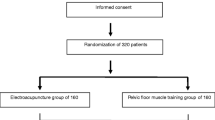Abstract
Objective
To observe the clinical efficacy of deep electroacupuncture (EA) at Baliao points in treating stress urinary incontinence (SUI).
Methods
A total of 60 female patients with SUI were divided into two groups according to the order of consultation, with 30 cases in each group. The control group was treated with pelvic floor muscle training. The treatment group was treated with deep EA at Baliao points [Shangliao (BL 31), Ciliao (BL 32), Zhongliao (BL 33) and Xialiao (BL 34)].
Results
The total effective rate was 93.3% in the treatment group, versus 33.3% in the control group, and the total effective rate of the treatment group was significantly higher than that of the control group (P<0.05). After treatment, the scores of international consultation on incontinence questionnaire-short form (ICIQ-SF) and the volume of urinary leakage in both groups were lower than those before treatment (all P<0.05), and the ICIQ-SF score and the volume of urinary leakage in the treatment group were lower than those in the control group (both P<0.05).
Conclusion
Deep EA at Baliao points with long needles can improve the clinical symptoms in female patients with SUI, and it has a better curative effect than pelvic floor muscle training.
摘要
目的
评价电针深刺八髎穴治疗压力性尿失禁的疗效。
方法
将60例压力性尿失禁的女性患者按就诊先 后顺序分为两组, 每组30例。对照组给予盆底肌训练, 治疗组给予电针深刺八髎穴(上髎、次髎、中髎和下髎)。
结果
治疗组总有效率为93.3%, 对照组为33.3%, 治疗组的总有效率明显高于对照组(P<0.05)。治疗后, 两组国 际尿失禁咨询委员会尿失禁问卷表简表(ICIQ-SF)评分及漏尿量均低于治疗前(均P<0.05), 治疗组ICIQ-SF评分及漏 尿量均低于对照组(均P<0.05)。
结论
长针深刺八髎穴能改善压力性尿失禁女性临床症状, 疗效优于盆底肌训练。
Similar content being viewed by others
References
Yu K, Xie ZG, Yu ZH, Liu S, Liu MP. Prevalence of urinary incontinence in Chinese adult women: a metaanalysis. Zhongguo Xunzheng Yixue Zazhi, 2019, 19(1): 36–43.
Wang KF. Status of stress urinary incontinence in female. Qiqihar Yixueyuan Xuebao, 2010, 31(11): 1782–1783.
Cao JS, Tan ZG, Cao Y, Zhang W. Exploration of the law about the use of the meridians and acupoints in the treatment of stress urinary incontinence with acupuncture. Zhenjiu Linchuang Zazhi, 2014, 30(9): 59–61.
Le XH, Wu HJ, Wang RH. Clinical study of the treatment of female stress incontinence by combined electroacupuncture and pelvic floor muscle exercises. Shanghai Zhenjiu Zazhi, 2008, 27(10): 18–19.
Xie ZN. Clinical experience of moxibustion in treating 13 cases of elderly women with stress urinary incontinence. Zhongguo Laonian Baojian Yixue, 2013, 11(6): 79.
Qin BS, Li YN, Shi J. Acupuncture plus Chinese medicine for stress urinary incontinence. Zhongguo Yixue Yanjiu Yu Linchuang, 2004, 2(1): 72.
Wang LZ, Wang J, Zhang P. Gu Quan Tie (solid springs paste) in treatment of female stress urinary incontinence. Liaoning Zhongyi Zazhi, 2013, 40(11): 2280–2282.
Zhang CZ, Lü YQ. Clinical observation on acupoint thread-embedding therapy plus functional exercise for treatment of stress urinary incontinence. Zhongguo Zhen Jiu, 2004, 24(7): 457–458.
Shi N, Liu LA. Clinical research progress of acupuncture on female stress urinary incontinence. Anmo Yu Kangfu Yixue, 2015, 6(9): 38–39.
Liu J, Yang SQ, Shi Y. Curative effect observation of needle warming moxibustion Ba Liao point combined with pelvic floor muscle exercise in the treatment of female stress urinary incontinence. Zhongguo Shequ Yishi, 2015, (8): 83–84.
Xu GJ, Xiao SQ, Yao G. Therapeutic observation of deep electroacupuncture at Baliao points for stress urinary incontinence. Xiandai Zhenduan Yu Zhiliao, 2014, (24): 5551–5552.
Bai Q. Therapeutic observation of acupuncture at Baliao points for stroke with urine retention. Xiandai Zhongxiyi Jiehe Zazhi, 2006, 15(8): 1079–1080.
Xu HY, Zhang H. Clinical observation of acupuncture combined with pelvic floor training for stroke with urinary incontinence. Shizhen Guoyi Guoyao, 2009, 20(1): 225–226.
Han LW. Efficacy observation on 38 cases of dysmenorrhea due to cold-dampness treated by gingerseparated moxibustion at Baliao points. Zhejiang Zhongyi Zazhi, 2018, 53(4): 279.
He XR, Ni GX, Niu SJ, Mao J. Clinical observation on 27 cases of analgesia for evacuation of uterus by preoperative acupuncture at Baliao points. Jiangsu Zhongyiyao, 2018, 50(3): 62–64.
Sun YB, Wu ZL, Xu YT. Eighty-two cases of chronic prostatitis treated by electroacupuncture at Baliao points. Zhongguo Zhen Jiu, 2010, 30(6): 490
Liu XJ. Baliao points warming needle moxibustion in the treatment of impotence 31 cases. Guangming Zhongyi, 2017, 32(15): 2227–2229.
Xu ZY. Efficacy observation of acupuncture at Baliao points plus tuina for L5-S1 intervertebral disc herniation. Shanghai Zhenjiu Zazhi, 2018, 37(8): 941–945.
Li M, Qin XG. Therapeutic observation of spread moxibustion at area of Baliao points for heel pain due to wind-dampness blockage. Shiyong Zhongyiyao Zazhi, 2018, 34(7): 845–846.
Long ZJ, Guan LC. Application of Baliao points plus Changqiang (GV 1) for anorectal neurosis. Zhongguo Zhongxiyi Jiehe Xiaohua Zazhi, 2014, 22(9): 547–548
Liu JZ, Liu BL, Gao YJ, Yang HQ, Jia GP, Xie SX, Song CX. Observation on the curative effect of electroacupuncture for Baliao acupoints combined with biofeedback in treating obstructive constipation. Zhongguo Zhongyiyao Xiandai Yuancheng Jiaoyu, 2018, 16(18): 110–112.
Athwal BS, Berkley KJ, Hussain I, Brennan A, Craggs M, Sakakibara R, Frackowiak RS, Fowler CJ. Brain responses to changes in bladder volume and urge to void in healthy men. Brain, 2001, 124(Pt 2): 369–377.
Acknowledgments
This work was supported by 2018 Project of Science and Technology Bureau of Wuxi (无锡市科技局2018 项目, No. WX18IIAN036); Medical Innovative Teambuilding Project of Wuxi Municipal Commission of Health and Family Planning (无锡市卫计委医学创新团队建设项目, No. CXTDJS006).
Author information
Authors and Affiliations
Corresponding author
Additional information
Conflict of Interest The authors declare that there is no conflict of interest in this article.
Statement of Informed Consent Informed consent was obtained from all individual participants.
Rights and permissions
About this article
Cite this article
Xu, L., Ding, M., Feng, H. et al. Clinical observation of deep electroacupuncture at Baliao points for female stress urinary incontinence. J. Acupunct. Tuina. Sci. 18, 111–115 (2020). https://doi.org/10.1007/s11726-020-1164-1
Received:
Accepted:
Published:
Issue Date:
DOI: https://doi.org/10.1007/s11726-020-1164-1
Keywords
- Acupuncture Therapy
- Electroacupuncture
- Acupuncture-moxibustion Therapy
- Urinary Incontinence, Stress
- Points, Baliao
- Women



